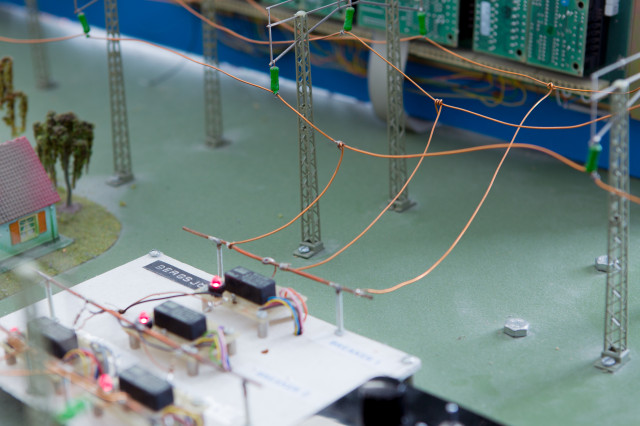Definition of plasma. Quasineutrality. Occurrence of plasmas. Charged particle motion. Adiabatic invariants. Microscopic and macroscopic description of plasma. Classification of plasma. Magnetohydrodynamics. Alfven waves and magnetoacoustic waves. Diffusion and resistivity. Generalized Ohm's law. Wave propagation in plasmas. Plasma instabilities. Landau damping. Production and diagnostics of plasmas in the laboratory. Technical plasma physics. Thermonuclear fusion. Plasma in space.
EF2200 Plasma Physics 6.0 credits

Information per course offering
Choose semester and course offering to see current information and more about the course, such as course syllabus, study period, and application information.
Information for Autumn 2026 Start 24 Aug 2026 programme students
- Course location
KTH Campus
- Duration
- 24 Aug 2026 - 23 Oct 2026
- Periods
Autumn 2026: P1 (6 hp)
- Pace of study
50%
- Application code
10844
- Form of study
Normal Daytime
- Language of instruction
English
- Course memo
- Course memo is not published
- Number of places
Min: 1
- Target group
- No information inserted
- Planned modular schedule
- [object Object]
- Schedule
- Schedule is not published
- Part of programme
- No information inserted
Contact
Course syllabus as PDF
Please note: all information from the Course syllabus is available on this page in an accessible format.
Course syllabus EF2200 (Spring 2019–)Content and learning outcomes
Course contents
Intended learning outcomes
Plasma physics is concerned with the properties of matter in the ionized state and its applications. The plasma state is characterized by complicated interactions between atomic, electric, mechanical and gasdynamic processes. Plasma physics in this way has connections to large parts of physics and electrical engineering and offers interesting possibilities for cross-field studies. Plasma physics forms the basis for space research, fusion research and a large and growing number of industrial applications. Modern plasma physics is a very active research field characterized of international cooperation.
After completing the course the participant should be able to
- define plasma state, give examples of different kinds of plasma and explain the parameters characterizing them
- analyze the motion of charged particles in electric and magnetic fields
- explain the concept of quasineutrality and describe plasma interaction with surfaces
- formulate kinetic and fluid descriptions of plasma, and understand the applicability of the appropriate approximations (ideal MHD, single fluid description, many fluid model).
- discuss plasma resistivity and diffusion in plasma based on the charged particle motion
- linearize equations describing plasma and derive differential equations for various types of waves in plasma and their dispersion relation
- explain the properties of the most important wave modes in plasma: dispersion relation, polarization and motion of the charged particles
- explain the concept of cutoff and resonance. Use the theory of electromagnetic wave propagation in plasma
- explain the concept of plasma instability, and analyze the instabilities based on the dispersion relation
- discuss interaction between particles and waves, Landau damping
- explain the use of thermonuclear fusion for energy production, and discuss problems with plasma confinement and current directions of research
- discuss technical applications of plasma; explain the most important methods for production and diagnostics of plasma in the laboratory
- show understanding of plasma processed relevant for the near-Earth environment, interplanetary space and astrophysical objects
- make estimates of various parameters in plasmas
Literature and preparations
Specific prerequisites
Electromagnetic field theory, e.g. EI1200 or equivalent.
Documented proficiency in english B or equivalent.
Recommended prerequisites
Basic knowledge of electromagnetism is required.
Literature
- D. A Gurnett and A. Bhattacharjee, Introduction to Plasma Physics, Cambridge University Press, 2005
- Francis F. Chen, Introduction to Plasma Physics and Controlled Fusion, Plenum Press, 2nd edition, 1984
- Carl-Gunne Fälthammar, Plasmafysik, kompendium, Stockholm 2001 (In Swedish)
- Material som delas ut under föreläsningarna
- P. M. Bellan, Fundamentals of Plasma Physics, Cambridge University Press, 2006
Examination and completion
Grading scale
Examination
- TEN1 - Examination, 6.0 credits, grading scale: A, B, C, D, E, FX, F
Based on recommendation from KTH’s coordinator for disabilities, the examiner will decide how to adapt an examination for students with documented disability.
The examiner may apply another examination format when re-examining individual students.
If the course is discontinued, students may request to be examined during the following two academic years.
Other requirements for final grade
Written examination, bonus points from hand-in assignments.
Examiner
Ethical approach
- All members of a group are responsible for the group's work.
- In any assessment, every student shall honestly disclose any help received and sources used.
- In an oral assessment, every student shall be able to present and answer questions about the entire assignment and solution.
Further information
Course room in Canvas
Offered by
Main field of study
Education cycle
Supplementary information
Replaces 2A1131
In this course, the EECS code of honor applies, see:
http://www.kth.se/en/eecs/utbildning/hederskodex.